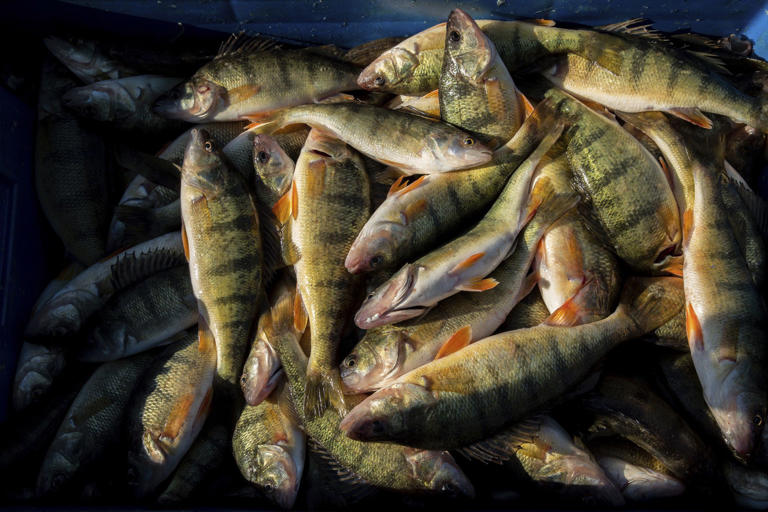Freshwater Fish Are Significantly More Contaminated With Toxic Forever Chemicals Than Saltwater Fish And Shellfish, Analysis Shows
Eating just one freshwater fish a year can dramatically increase the amount of toxic forever chemicals coursing through a person’s blood, according to a new study that reflects more than a half century of pollution contaminating the Great Lakes and rivers nationwide.
Eating just one freshwater fish a year can dramatically increase the amount of toxic forever chemicals coursing through a person’s blood, according to a new study that reflects more than a half century of pollution contaminating the Great Lakes and rivers nationwide.
 Brown trout raised from the Illinois DNR's Jake Wolf Memorial Fish Hatchery are dropped into Belmont Harbor in Chicago in 2017.© Jose M. Osorio/Chicago Tribune/TNS
Brown trout raised from the Illinois DNR's Jake Wolf Memorial Fish Hatchery are dropped into Belmont Harbor in Chicago in 2017.© Jose M. Osorio/Chicago Tribune/TNS
The alarming finding is based on an analysis of hundreds of fish caught by the U.S. Environmental Protection Agency since 2013. Though the EPA has concluded some of the chemicals are harmful at any level, the agency hasn’t drawn attention to its fish sampling or warned Americans they could be in danger.
Nearly every fish tested by the EPA was tainted with perfluorooctane sulfonate or PFOS, a forever chemical used for decades in Scotchgard stain-resistant fabrics, firefighting foam and food packaging manufactured by Minnesota-based 3M.
PFOS builds up in human blood, doesn’t break down in the environment and triggers health problems such as liver damage, impaired fertility, immune system disorders, thyroid disease, increased cholesterol levels and reduced vaccine effectiveness. Long-term exposure also might cause cancer.
“These findings point to the urgent need to eliminate more releases of these chemicals into the environment,” said David Andrews, a senior scientist at the nonprofit Environmental Working Group and one of the authors of the new study. “We don’t want this problem to get any worse, especially knowing how long it’s going to take for it to get better.”
 Yellow perch and other fish caught by a commercial fishermen in Lake Erie near Sandusky, Ohio, in 2019.© Zbigniew Bzdak/Chicago Tribune/TNS
Yellow perch and other fish caught by a commercial fishermen in Lake Erie near Sandusky, Ohio, in 2019.© Zbigniew Bzdak/Chicago Tribune/TNS
To put that number into context, the nationwide median of PFOS in drinking water is estimated to be less than 5 ppt. The highest concentration detected in Chicago drinking water so far is 2.8 ppt.
In June, the EPA announced there is effectively no safe exposure to PFOS and a related chemical, PFOA.
Exposure from eating fish is of particular concern for Native Americans, certain immigrant communities and low-income Americans who depend on lakes and rivers for a significant portion of their diet, Andrews noted, citing other studies.
Freshwater fish in the United States appear to be significantly more contaminated than seafood. The median concentration of forever chemicals in the EPA testing was 278 times higher than what the Food and Drug Administration found during the past four years in saltwater fish, shrimp, lobster, clams and oysters.
 Fishermen try their luck in Lake Michigan near The Bush neighborhood in Chicago on Dec. 25, 2021.© Terrence Antonio James/Chicago Tribune/TNS
Fishermen try their luck in Lake Michigan near The Bush neighborhood in Chicago on Dec. 25, 2021.© Terrence Antonio James/Chicago Tribune/TNS
The highest level of PFOS detected in Great Lakes fish — 64,400 parts per trillion — came from white perch caught in Lake Erie near Monroe, Michigan, a Chicago Tribune review of EPA data found.
Yellow perch in Lake Michigan near Holland, Michigan, and Whiting were tainted with 22,900 ppt and 12,500 ppt, respectively. The level in walleye caught off the Door County peninsula in Wisconsin: 11,500 ppt.
EPA sampling in the Great Lakes during 2013 through 2015 did not include fish from Illinois waters. But in 2010 the agency found 19,000 ppt of PFOS in brown trout caught off North Avenue Beach in Chicago.
Disturbing levels also have been detected in the nation’s rivers and streams.
Northwest of Madison, the EPA found 74,200 ppt in smallmouth bass caught in the Wisconsin River. Upstream from Cave-in-Rock in deep southern Illinois, channel catfish pulled from the Ohio River had a whopping 135,000 ppt of PFOS.
Closer to Chicago, the agency found 25,500 ppt in channel catfish from the Fox River in Lake Barrington. The level in smallmouth bass from the Kankakee River near Bourbonais: 9,530 ppt.
Unlike other toxic substances such as mercury or PCBs, worrisome concentrations of forever chemicals aren’t limited to specific types of fish, EPA data shows. PFOS and related compounds — known as per- and polyfluoroalkyl substances or PFAS — bind to fish tissue and can’t be cooked or trimmed out.
“Mercury, for example, tends to be higher in bigger, older fish,” said Gavin Dehnert, an emerging contaminants researcher at Wisconsin Sea Grant who, along with several Indigenous tribes in the Upper Midwest, recently launched another study of PFAS in the region’s lakes, rivers and fish. “With PFAS you can have high levels in panfish, common carp or smelt, tiny fish that are near the bottom of the food chain.”
Andrews speculated one reason why the EPA hasn’t publicized its test results is because fish are an important source of protein and other nutrients. Burdening Americans with PFAS isn’t worth the trade-offs, he said.
PFAS still aren’t regulated in the United States. The Biden administration is proposing to list PFOS and PFOA as hazardous substances under federal law, which would make it easier to force polluters to clean up contaminated sites at their own expense. Other rule-making is expected to establish the first enforceable limits on the chemicals in drinking water.
After this story appeared online Tuesday, the EPA emailed a statement vowing to provide states and tribal governments this spring with more information about the health risks of PFAS in fish.
“EPA is bringing a renewed focus and urgency to using all of its relevant authorities to identify and reduce PFAS discharges into the environment,” the agency said in its statement.
A national consumption advisory isn’t on the Biden administration’s agenda, though some states, including Michigan, Minnesota and Wisconsin, already caution people to limit or avoid eating certain fish based on PFOS contamination. Illinois officials only recently began surveying the state’s lakes and rivers for the forever chemical.
EPA fish sampling in the lower 48 states suggests current advisories aren’t protective enough.
Faced with hundreds of lawsuits, 3M announced last month it will stop making all PFAS by 2025, a quarter century after the company phased out PFOS, PFOA and several related compounds the global conglomerate pioneered after World War II. Scientists are finding replacements for PFOS and PFOA, introduced during the 2000s, are just as harmful, if not more so.
High levels of PFOS still being found in fish shows how persistent the chemical is in the environment.
“People are getting PFAS from so many different places, from their diet and from water,” said Christy Remucal, an associate professor of civil and environmental engineering at the University of Wisconsin who researches forever chemicals but was not involved in the new study.
“You never want to hear that these chemicals whose names you can’t pronounce are in the water you’re drinking or the fish you’re eating,” Remucal said. “Some people panic and some people decide they can’t avoid it so why worry. That makes communicating the risks very challenging.”
Publication: Nadia Barbo, et al., Locally caught freshwater fish across the United States are likely a significant source of exposure to PFOS and other perfluorinated compounds, Science Direct (2023). DOI: 10.1016/j.envres.2022.115165
Original Story Source: University of Wisconsin-Madison

 Alerts Sign-up
Alerts Sign-up